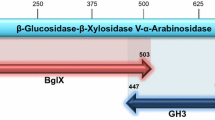Abstract
The full-length cDNA gene that encodes an acidophilic endo-1,4-β- xylanase XynI of Aspergillus usamii E001 was amplified by rapid amplification of cDNA 3′ and 5′ ends (RACE) using the total RNA as template and then cloned onto the pUCm-T vector, followed by sequencing. The cloned cDNA is 881 bp in length including 5′ and 3′ non-encoding regions, as well as a 678 bp of open reading frame (ORF) which encodes an E001 XynI of 188 amino acid residues together with a signal peptide of 37 amino acid residues. The homologies of E001 XynI with xylanases of Aspergillus niger, Aspergillus kawachii, Emericella nidulans and Penicillium funiculosum are 97.8, 92.0, 74.6 and 60.5%, respectively. From a BLAST search result, we concluded that E001 XynI belongs to the glycoside hydrolase family 11. Its three-dimensional structure was predicted using http://swiss-model.expasy.org/on-line programs based on that of the P. funiculosum xylanase (1TE1B) from the family 11. In addition, the complete DNA gene xynI encoding E001 XynI was cloned from the genomic DNA of A. usamii E001 by conventional PCR and ligation-mediated PCR amplification. The cloned xynI is 1,206 bp in length, composed of a promoter region, a 68 bp of intron and two exons when compared with the cDNA of E001 XynI.







Similar content being viewed by others
References
Asha PC, Prema P (2007) Production of cellulase-free endoxylanase from novel alkalophilic thermotolerent Bacillus pumilus by solid-state fermentation and its application in wastepaper recycling. Biores Technol 98:485–490
Collins T, Gerday C, Feller G (2005) Xylanases, xylanase families and extremophilic xylanases. FEMS Microbiol Rev 29:3–23
Dalboge H, Heldt-Hansen HP (1994) A novel method for efficient expression cloning of fungal enzyme genes. Mol Gen Genet 243:253–260
Fu DD, Xie H, Wu MC (2005) Solid fermentation for xylanase production by Aspergillus usamii. Food Ferment Ind 31:50–53
Hakulinen N, Turunen O, Janis J, Leisola M, Rouvinen J (2003) Three-dimensional structures of thermophilic beta-1, 4-xylanases from chaetomium thermophilum and Nonomuraea flexuosa. Comparison of twelve xylanases in relation to their thermal stability. Eur J Biochem 270:1399–1412
Huang JL, Wang GX, Xiao L (2006) Cloning, sequencing and expression of the xylanase gene from a Bacillus subtilis strain B10 in Escherichia coli. Biores Technol 97:802–808
Khandeparker R, Numan MTh (2008) Bifunctional xylanases and their potential use in biotechnology. J Ind Microbiol Biotechnol 35:635–644
Krengel U, Dijkstra W (1996) Three-dimensional structure of endo-1, 4-β-xylanase I from Aspergillus niger: molecular basis for its low pH optimum. J Mol Biol 263:70–78
Oakley AJ, Heinrich T, Thompson CA, Wilce MC (2003) Characterization of a family 11 xylanase from Bacillus subtillis B230 used for paper bleaching. Acta Crystallogr D Biol Crystallogr 59:627–636
Pastor FIJ, Gallardo O, Sanz-Aparicio J, Diaz P (2007) Xylanases: molecular properties and applications. In: Polaina J, MacCabe AP (eds) Industrial enzymes. Springer, Germany, pp 65–82
Polizeli MLTM, Rizzatti ACS, Monti R (2005) Xylanases from fungi: properties and industrial applications. Appl Microbiol Biotechnol 67:577–591
Rakhee K, Narayan BB (2007) Application of thermoalkalophilic xylanase from Arthrobacter sp. MTCC 5214 in biobleaching of kraft pulp. Biores technol 98:897–903
Sambrook J, Russell DW (2001) Molecular cloning: a laboratory manual, 3rd edn. Cold Spring Harbor Laboratory Press, New York
Sapag A, Wouters J, Lambert C, de Ioannes P, Eyzaguirre J, Depiereux E (2002) The endoxylanases from family 11: computer analysis of protein sequences reveals important structural and phylogenetic relationships. J Biotechnol 95:109–131
Srivastava P, Mukherjee KJ (2001) Cloning, characterization, and expression of xylanase gene from Bacillus lyticus in Escherichia coli and Bacillus subtilis. Prep Biochem Biotechnol 31:389–400
Techapun C, Poosaran N, Watanabe M, Sasaki K (2003) Thermostable and alkaline- tolerant microbial cellulose-free xylanases produced from agricultural wastes and the properties required for use in pulp bleaching bioprocesses: a review. Process Biochem 38:1327–1340
Verma IM (1977) Reverse transcriptase. In: Boyer PD (ed) The enzymes. Academic Press, New York, pp 87–104
Vickers CE, Xue GP, Gresshoff PM (2003) A synthetic xylanase as a novel reporter in plants. Plant Cell Rep 22:135–140
Wang SL, Zhu J, Wu MC (2006) Studies on purification and properties of xylanase. J Northwest Sci-Tech Univ of Agr & For 34:71–76
Wendland J, Lengeler KB, Kothe E (1996) An instant preparation method for mucleic acids of filamentous fungi. Fungal Genet Newslett 43:54–55
Wu SS, Suen DF, Chang HC, Huang AH (2002) Maize tapetum xylanase is synthesized as a precursor, processed and activated by a serine protease, and deposited on the pollen. J Biol Chem 277:49055–49064
Wu MC, Qian ZK, Jiang PH, Min TS, Sun CG, Huang WD (2003) Cloning of an alkaline lipase gene from Penicillium cyclopium and its expression in Escherichia coli. Lipids 38:191–199
Wu MC, Fu DD, Zhu J, Xia MF (2005) Purification and some properties of two xylanases from Aspergillus usamii. J Food Sci Biotechnol 24:29–33
Zhou CY, Bai JY, Deng SS, Wang J, Zhu J, Wu MC, Wang W (2007) Cloning of a xylanase gene from Aspergillus usamii and its expression in Escherichia coli. Biores Technol 99:831–838
Acknowledgments
This work was supported by a grant from the National Nature Science Foundation of China (No. 20776061). We are grateful to Prof. Weida Huang (Department of Biochemistry, School of life Sciences, Fudan University) for providing technical assistance.
Author information
Authors and Affiliations
Corresponding author
Rights and permissions
About this article
Cite this article
Wu, M., Wang, J., Zhang, H. et al. Cloning and sequence analysis of an acidophilic xylanase (XynI) gene from Aspergillus usamii E001. World J Microbiol Biotechnol 27, 831–839 (2011). https://doi.org/10.1007/s11274-010-0525-1
Received:
Accepted:
Published:
Issue Date:
DOI: https://doi.org/10.1007/s11274-010-0525-1




